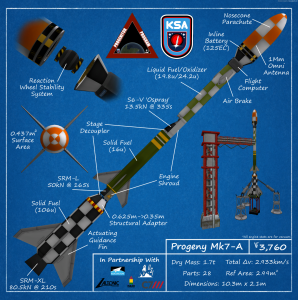Under development for over a year (the Progeny Mk6 debuted in Feb 2018), the latest iteration in the Progeny line of rockets will aim to satisfy new goals for the program – being able to deploy 0.35-0.625m payloads to Low-Kerbin Orbit (70-250km). The Mk7 series will also test out several new technologies that will work their way up to our bigger rockets such as vectoring engines, reaction wheel stability control systems, fully-actuating guidance fins, payload fairings, inline & more compact/lighter batteries. While we had hoped the Mk7-A could reach orbit, its primary design purpose will be to test the new form factor of a 0.625m payload atop a 0.35m stack in the final stage.
Another design consideration for all the Mk7 rockets is to be compatible with the pad infrastructure put in place for Ascension rockets, including the engine collar and resource towers. This will save time and money as we will no longer need to switch out the engine collar for a dedicated launch base. An insert for the engine collar will cradle the lower-stage booster while three stabilizers will help hold the rocket steady once the upper umbilical tower swings away from the liquid fuel tank and will retract moments before booster ignition. The lower umbilical tower will not be used.
The ‘-A’ designation of the rocket signifies that there will be several iterations yet to come but all will be working to achieve the same goal stated earlier. The Progenitor team already recognizes that they will be needing a more powerful second stage solid and the lower solid may need to have a new core designed as it was meant for lighter payloads carried up on sub-orbital trajectories with earlier Mk5 & Mk6 rockets.
First launch of the Mk7-A could happen as early as June.








